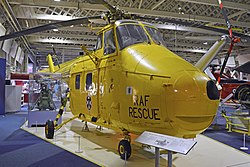- Westland Whirlwind HAR.10 XP299 which was operated by 1563 Flt at RAF Akrotiri from June 1969 to April 1970.
- Whirlwind helicopter (XD184), previously of 1563 Flt and No. 84 Squadron, at RAF Akrotiri, Cyprus.
- A Puma helicopter of 1563 Flt at Xunantunich.
- XW202 (CE), a Puma HC.1 of 1563 Flt in the Belizean Jungle, 14 August 1991.
- XW213 (CJ), a Puma HC1 of No. 1563 Flight on the helicopter operating platform at Williamson Hangar, Philip S.W. Goldson International Airport on 13 August 1991.
| No. 1563 Flight RAF | |
|---|---|
 | |
| Active | 1 – 18 March 1941 [1] 18 January – 4 April 1942 1 Nov 1953 – 1 Oct 1958 1 Mar 1963 – 8 Sep 1967 18 Apr 1980 – 6 Jul 1993 2022 – May 2023 |
| Country | |
| Branch | |
| Type | Independent flight |
| Role | Helicopter medium-lift support |
| Part of | Joint Helicopter Command |
| Aircraft | Westland Puma HC2 |
No. 1563 Flight Royal Air Force (1563 Flt) was an independent flight of the Royal Air Force (RAF). The flight formerly operated the Westland Puma HC2 helicopters in Brunei Darussalam. It previously flew tactical support missions for locally garrisoned British Army units, as well as Belize Defence Force units in Belize. Between 1963 and 1972, it was stationed at RAF Akrotiri flying Westland Whirlwind HAR.10 helicopters on support missions for locally garrisoned British Army and United Nations troops.





